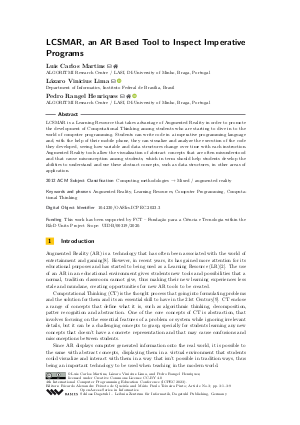LCSMAR, an AR Based Tool to Inspect Imperative Programs
Authors
Luis Carlos Martins,
Lázaro Vinicius Lima  ,
Pedro Rangel Henriques
,
Pedro Rangel Henriques 
-
Part of:
Volume:
4th International Computer Programming Education Conference (ICPEC 2023)
Part of: Series: Open Access Series in Informatics (OASIcs)
Part of: Conference: International Computer Programming Education Conference (ICPEC) - License:
 Creative Commons Attribution 4.0 International license
Creative Commons Attribution 4.0 International license
- Publication Date: 2023-08-09
File

PDF
OASIcs.ICPEC.2023.3.pdf
- Filesize: 10.12 MB
- 9 pages
Document Identifiers
Subject Classification
ACM Subject Classification
- Computing methodologies → Mixed / augmented reality
Keywords
- Augmented Reality
- Learning Resources
- Computer Programming
- Computational Thinking
Metrics
- Access Statistics
-
Total Accesses (updated on a weekly basis)
0Document
0Metadata
Abstract
LCSMAR is a Learning Resource that takes advantage of Augmented Reality in order to promote the development of Computational Thinking among students who are starting to dive in to the world of computer programming. Students can write code in a imperative programming language and, with the help of their mobile phone, they can visualize and analyze the execution of the code they developed, seeing how variable and data structures change over time with each instruction. Augmented Reality tools allow the visualization of abstract concepts that are often misunderstood and that cause misconception among students, which in term should help students develop the abilities to understand and use these abstract concepts, such as data structures, in other areas of application.
Cite As Get BibTex
Luis Carlos Martins, Lázaro Vinicius Lima, and Pedro Rangel Henriques. LCSMAR, an AR Based Tool to Inspect Imperative Programs. In 4th International Computer Programming Education Conference (ICPEC 2023). Open Access Series in Informatics (OASIcs), Volume 112, pp. 3:1-3:9, Schloss Dagstuhl – Leibniz-Zentrum für Informatik (2023)
https://doi.org/10.4230/OASIcs.ICPEC.2023.3
BibTex
@InProceedings{martins_et_al:OASIcs.ICPEC.2023.3,
author = {Martins, Luis Carlos and Lima, L\'{a}zaro Vinicius and Henriques, Pedro Rangel},
title = {{LCSMAR, an AR Based Tool to Inspect Imperative Programs}},
booktitle = {4th International Computer Programming Education Conference (ICPEC 2023)},
pages = {3:1--3:9},
series = {Open Access Series in Informatics (OASIcs)},
ISBN = {978-3-95977-290-7},
ISSN = {2190-6807},
year = {2023},
volume = {112},
editor = {Peixoto de Queir\'{o}s, Ricardo Alexandre and Teixeira Pinto, M\'{a}rio Paulo},
publisher = {Schloss Dagstuhl -- Leibniz-Zentrum f{\"u}r Informatik},
address = {Dagstuhl, Germany},
URL = {https://drops.dagstuhl.de/entities/document/10.4230/OASIcs.ICPEC.2023.3},
URN = {urn:nbn:de:0030-drops-184994},
doi = {10.4230/OASIcs.ICPEC.2023.3},
annote = {Keywords: Augmented Reality, Learning Resources, Computer Programming, Computational Thinking}
}
Author Details
Funding
This work has been supported by FCT – Fundação para a Ciência e Tecnologia within the R&D Units Project Scope: UIDB/00319/2020.
References
-
Ronald T Azuma. A survey of augmented reality. Presence: teleoperators & virtual environments, 6(4):355-385, 1997.

-
Matt Bower, Cathie Howe, Nerida McCredie, Austin Robinson, and David Grover. Augmented reality in education-cases, places and potentials. Educational Media International, 51(1):1-15, 2014.

-
Rona Bušljeta. Effective use of teaching and learning resources. Czech-Polish historical and pedagogical journal, 5(2), 2013.

-
Bárbara Cleto, Cristina Sylla, Luís Ferreira, and João Martinho Moura. Codecubes: Coding with augmented reality. In First international computer programming education conference (ICPEC 2020). Schloss Dagstuhl-Leibniz-Zentrum für Informatik, 2020.

-
Qiao Jin, Danli Wang, Xiaozhou Deng, Nan Zheng, and Steve Chiu. Ar-maze: a tangible programming tool for children based on ar technology. In Proceedings of the 17th ACM Conference on Interaction Design and Children, pages 611-616, 2018.

-
Paul Milgram, Haruo Takemura, Akira Utsumi, and Fumio Kishino. Augmented reality: A class of displays on the reality-virtuality continuum. In Telemanipulator and telepresence technologies, volume 2351, pages 282-292. Spie, 1995.

-
Mitchel Resnick, John Maloney, Andrés Monroy-Hernández, Natalie Rusk, Evelyn Eastmond, Karen Brennan, Amon Millner, Eric Rosenbaum, Jay Silver, Brian Silverman, et al. Scratch: programming for all. Communications of the ACM, 52(11):60-67, 2009.

- Karen Schrier. Using augmented reality games to teach 21st century skills. In ACM SIGGRAPH 2006 Educators Program, SIGGRAPH '06, pages 15-es. Association for Computing Machinery, New York, NY, USA, 2006. URL: https://doi.org/10.1145/1179295.1179311.
-
Jeannette M Wing. Computational thinking benefits society. 40th anniversary blog of social issues in computing, 2014:26, 2014.

